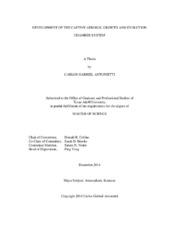Development of the Captive Aerosol Growth and Evolution Chamber System
Abstract
The Captive Aerosol Growth and Evolution (CAGE) Chamber System is an tool designed to study the evolution of aerosols under conditions identical or similar to those of the surrounding environment. Our motivation was to quantify the sensitivity of particle growth rate to trace gas concentrations, oxidants, other particles, and cloud processing. The main objective was to design a pair of transparent, chemically inert, and rotating chambers capable of withstanding a vacuum reflective of typical cloud-top pressures. Aerosol samples taken from the chambers are directed into a suite of instrumentation to study the physical and chemical properties of the evolving aerosol.
The chamber system is mounted on a field-deployable trailer through a rotating frame that tracks the sun. Each chamber consists of a set of three concentric thin film cylinders. On both ends of each chamber are inlets and outlets connected through rotary unions for control of trace gas and particle concentrations in the reactor volumes, which rotate about horizontal axes to extend particle retention time. The cylindrical chamber walls are made of transparent FEP Teflon that is both chemically inert and largely transparent for natural solar radiation that drives photo-oxidation processes. The reactor cylinder end walls are made of a permeable Teflon membrane for gas exchange between the inside of the chamber and pre- conditioned or filtered ambient gas. This continuous gas exchange permits dynamic control of the chamber composition without the particle dilution that would accompany a flow- through design. The gas composition in the chambers can be varied for different experimental objectives. Controlled pressure differentials between the concentric volumes are designed to keep the walls semi-rigid during an experiment, while the outermost wall and high strength metal support frame withstand the vacuum in the chambers relative to surrounding air that becomes quite large during cloud formation cycles.
The CAGE system was first deployed during September and October 2012 at the Army Research Laboratory outside of Washington D.C. where basic functionalities were tested and experiments conducted to assess the rate at which bioaerosol properties and viability change in ambient air. Daily experiments lasted up to 7 hours, with both chambers rotating at 1 rpm and the platform rotating to track the sun. Injection of two different aerosol types with nearly monodisperse size distribution was followed by intermittent measurement and collection of those captive particles. The gas exchanged with one chamber was first scrubbed and filtered to provide a baseline for comparison while particle-filtered ambient air was exchanged with the other chamber. Preliminary results indicate that single particle fluorescence spectra vary both over time and with differing gas composition.
Citation
Antonietti, Carlos G (2014). Development of the Captive Aerosol Growth and Evolution Chamber System. Master's thesis, Texas A & M University. Available electronically from https : / /hdl .handle .net /1969 .1 /153855.


